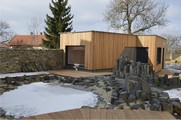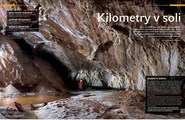Institute of Geology AS CR, v. v. i.
Medium-sized research center which main purpose is to gain, interpret and integrate the knowledge of the Earth System.
News
The unique Centre for Didactics of Geology will be opened in Říčany
 The Centre for Didactic of Geology will be ceremonially opened on April 9th 2015 at 14.00. One of the
The Centre for Didactic of Geology will be ceremonially opened on April 9th 2015 at 14.00. One of the
collaborators is Petr Schnabl from the Institute of Geology CAS, v. v. i. The ceremony will take place at
the garden of the 1st Elementary School Říčany at Masaryk square.
The invitation card (in Czech) is here.
Professor Zdeněk V. Špinar - memorial meeting
 The memorial meeting at the occasion of the centenary birth and twenty years death celebration of the outstanding
The memorial meeting at the occasion of the centenary birth and twenty years death celebration of the outstanding
Czech palaeontologist Professor Zdeněk V. Špinar will take place in the meeting room of the Institute of Geology AS
CR, v. v. i. on 11th November 2015.
The invitation is downloadable here (in Czech).
Radek Mikuláš spoke about stromatoliths in the Czech radio programme "Studio Leonardo"
 Stromatolites are often reported as the oldest macroscopic fossils of the Earth. But what do we really
Stromatolites are often reported as the oldest macroscopic fossils of the Earth. But what do we really
know on them?
The recorded broadcast id here (in Czech)
Vernissage of the exhibition "Landscape of the old mining areas in the neighbourhood of Tábor" in Café Barrande
 The vernissage of the exhibition "Landscape of the old mining areas in the neighbourhood of Tábor" of
The vernissage of the exhibition "Landscape of the old mining areas in the neighbourhood of Tábor" of
Jiří Žítt from the Institute of Geology CAS, v. v. i. went in Café Barrande together with exhibition of
graphics of Jan Sklenář (National Muzeum, Prague) went in Café Barrande 5th March, 2015. The
exhibition will take up to 26th March, 2015.
Some photographs are here.
Michal Filippi contributed to the interview for the Příroda (Nature) Magazine
 Michal Filippi of the Institute of Geology CAS, v.v.i., together with Jiří Bruthans (Faculty of
Michal Filippi of the Institute of Geology CAS, v.v.i., together with Jiří Bruthans (Faculty of
Science, Charles University in Prague) and Milan Geršl (Mendel University in Brno)
contributed to the interview about discoveries in the Iranian salt karst for the Příroda
Magazine (Nature) Magazine, No. 3-4, 2015.
For the contents of the mentioned issue see here (in Czech).
Matters of interest
Cryogenic cave carbonates – a new tool to estimate the minimum permafrost depth of the Last Glacial
Cryogenic cave carbonates can be identified in caves based on their characteristic mode of occurrence, typical shape, unique carbon and oxygen stable isotope compositions, and based on ages confirming their formation during the Glacial. Low-ventilation caves generally show temperature close to those of the surrounding rock. Cooling of such caves to freezing and/or subfreezing temperature is possible only due to evolution of permafrost (permafrost is the zone of soils and rocks having temperature 0 °C or lower for at least two subsequent years).
Ichnofossils associated with slightly skeletonized body fossils, Middle Cambrian of the Barrandian area, Czech Republic
Sediments of the Middle Cambrian of the Barrandian area yielded several distinct morphotypes of ichnofossils preserved in a tight association with non- or slightly-mineralized animal body fossils, most often arthropods. These traces, in lesser diversity, were described from the Cambrian of the Barrandian area already in 2000 by the present author. Later, since 2006, analogous trace fossils have been described from classical Cambrian lagerstätten, namely Chengjiang and Burgess.
Mineral inclusions in placer zircon from the Ohře (Eger) Graben: New data on „strontiopyrochlore“
After qualitative examination of the inclusion inventory of 80 zircon megacrysts from alluvial placers of the Cenozoic alkali basalt area of northern Bohemia and southeastern Saxony, three representative megacrysts from the Podsedice deposit were selected for an in-depth study of inclusion minerals. Primary and secondary inclusions were distinguished and used as monitor for zircon-related syn- and epigenetic processes.
Interpretation of the Teplice Caldera history based on the LA-ICP-MS study of quartz crystal zoning
The Altenberg–Teplice Caldera (eastern Krušné Hory/Erzebirge) is the largest Variscan volcano-plutonic complex in the Bohemian Massif. It is composed of co-magmatic volcanics (peraluminous basal rhyolite and associated dacite, overlying three units of subaluminous Teplice rhyolite and granite porphyry) and plutonic granites (two intrusions of A-type granites). In this study, the internal structures and trace-element distributions within quartz grains were investigated using a laser ablation ICP-MS combined with a hot-cathode and scanning cathodoluminescence analysis.
Kozlowskii Event: mass faunal extinction and global environmental perturbations recorded in the upper Silurian succession of the Prague Synform.
Ladislav Slavík, Petr Štorch
About Institute
 Institute of Geology AS CR, v. v. i. is a medium-sized research center which main purpose is to gain, interpret and integrate the knowledge of the Earth System and its geologic and biologic past, without which it would not be possible to understand the recent environment. The Earth system understood as a result of interaction of endogenous and exogenous geological processes, development of biota and anthropogenic effects. Co-evolution of the Earth system means close connection and constant mutual influence of biotic and abiotic processes resulting in changes of atmosphere composition, climatic changes and weathering rates, relief development, sedimentary basin development and genesis of some types of natural resource bearings.
Institute of Geology AS CR, v. v. i. is a medium-sized research center which main purpose is to gain, interpret and integrate the knowledge of the Earth System and its geologic and biologic past, without which it would not be possible to understand the recent environment. The Earth system understood as a result of interaction of endogenous and exogenous geological processes, development of biota and anthropogenic effects. Co-evolution of the Earth system means close connection and constant mutual influence of biotic and abiotic processes resulting in changes of atmosphere composition, climatic changes and weathering rates, relief development, sedimentary basin development and genesis of some types of natural resource bearings.

